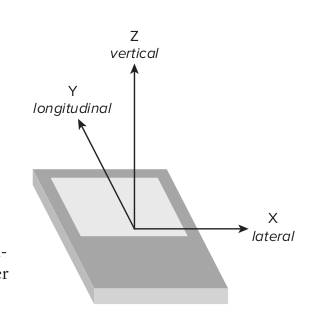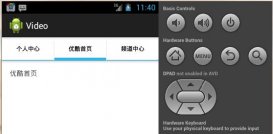本文实例讲述了android基于sensor感应器获取重力感应加速度的方法。分享给大家供大家参考,具体如下:
fetc项目指导老师提出了新的需求,想要在游戏地图中表现出用户用户当期移动的方向,再用gps的话显然很不靠谱,所以想到了android强大的感应器。。。
很多移动设备都内置了感应器,android通过sensor和sensormanager类抽象了这些感应器,通过这些类可以使用android设备的传感器
一 介绍sensor类
sdk只有一句介绍“class representing a sensor. use getsensorlist(int) to get the list of available sensors.”,表示一个感应器的类,可以使用getsensorlist方法(此方法属于接下来要讲的sensormanager)获得所有可用的感应器,该方法返回的是一个list<sensor>
下面的列表显示了,sensor所提供的所有服务
constants
int type_accelerometer a constant describing an accelerometer sensor type.
//三轴加速度感应器 返回三个坐标轴的加速度 单位m/s2
int type_all a constant describing all sensor types.
//用于列出所有感应器
int type_gravity a constant describing a gravity sensor type.
//重力感应器
int type_gyroscope a constant describing a gyroscope sensor type
//陀螺仪 可判断方向 返回三个坐标轴上的角度
int type_light a constant describing an light sensor type.
//光线感应器 单位 lux 勒克斯
int type_linear_acceleration a constant describing a linear acceleration sensor type.
//线性加速度
int type_magnetic_field a constant describing a magnetic field sensor type.
//磁场感应 返回三个坐标轴的数值 微特斯拉
int type_orientation this constant is deprecated. use sensormanager.getorientation() instead.
//方向感应器 已过时 可以使用方法获得
int type_pressure a constant describing a pressure sensor type
//压力感应器 单位 千帕斯卡
int type_proximity a constant describing an proximity sensor type.
//距离传感器
int type_rotation_vector a constant describing a rotation vector sensor type.
//翻转传感器
int type_temperature a constant describing a temperature sensor type
//温度传感器 单位 摄氏度
此类中包含的方法都是get型的 用来获取所选sensor的一些属性,sensor类一般不需要new而是通过sensormanager的方法获得
二 介绍sensormanager类
sdk解释:“sensormanager lets you access the device's sensors. get an instance of this class by calling context.getsystemservice() with the argument sensor_service.
always make sure to disable sensors you don't need, especially when your activity is paused. failing to do so can drain the battery in just a few hours. note that the system will not disable sensors automatically when the screen turns off. ”
sensormanager 允许你访问设备的感应器。通过传入参数sensor_service参数调用context.getsystemservice方法可以获得一个sensor的实例。永远记得确保当你不需要的时候,特别是activity暂定的时候,要关闭感应器。忽略这一点肯能导致几个小时就耗尽电池,注意当屏幕关闭时,系统不会自动关闭感应器。
三 常用的感应器
(1) 加速度感应器
可以通过这个感应器获得三个浮点型
x-axis
y-axis
z-axis
可参阅《android 高级编程2》中的一个插图分析次数据

x y z分别对应values[0]到[2]
x表示左右移动的加速度
y表示前后移动的加速度
z表示垂直方向的加速度 (测试时发现,将手机置于水平桌面稳定后 xy均为0 z的值为9.4 约等于重力加速度,依次可以做一个简单的算法实现重力测力计,有时间会给大家一个例子)
下面先看一个基本的获取加速的demo,希望大家好好注意代码中的注释
|
1
2
3
4
5
6
7
8
9
10
11
12
13
14
15
16
17
18
19
20
21
22
23
24
25
26
27
28
29
30
31
32
33
34
35
36
37
38
39
40
41
42
43
44
45
46
47
48
49
50
51
52
53
54
55
56
57
58
59
60
61
62
63
64
65
66
67
68
69
70
71
|
/* * @author octobershiner * 2011 07 27 * se.hit * 一个演示android加速度感应器的例子 * */package uni.sensor;import java.util.iterator;import java.util.list;import android.app.activity;import android.content.context;import android.hardware.sensor;import android.hardware.sensorevent;import android.hardware.sensoreventlistener;import android.hardware.sensormanager;import android.os.bundle;import android.util.log;public class sensordemoactivity extends activity { /** called when the activity is first created. */ //设置log标签 private static final string tag = "sensor"; private sensormanager sm; @override public void oncreate(bundle savedinstancestate) { super.oncreate(savedinstancestate); setcontentview(r.layout.main); //创建一个sensormanager来获取系统的传感器服务 sm = (sensormanager)getsystemservice(context.sensor_service); //选取加速度感应器 int sensortype = sensor.type_accelerometer; /* * 最常用的一个方法 注册事件 * 参数1 :sensoreventlistener监听器 * 参数2 :sensor 一个服务可能有多个sensor实现,此处调用getdefaultsensor获取默认的sensor * 参数3 :模式 可选数据变化的刷新频率 * */ sm.registerlistener(myaccelerometerlistener,sm.getdefaultsensor(sensortype),sensormanager.sensor_delay_normal); } /* * sensoreventlistener接口的实现,需要实现两个方法 * 方法1 onsensorchanged 当数据变化的时候被触发调用 * 方法2 onaccuracychanged 当获得数据的精度发生变化的时候被调用,比如突然无法获得数据时 * */ final sensoreventlistener myaccelerometerlistener = new sensoreventlistener(){ //复写onsensorchanged方法 public void onsensorchanged(sensorevent sensorevent){ if(sensorevent.sensor.gettype() == sensor.type_accelerometer){ log.i(tag,"onsensorchanged"); //图解中已经解释三个值的含义 float x_lateral = sensorevent.values[0]; float y_longitudinal = sensorevent.values[1]; float z_vertical = sensorevent.values[2]; log.i(tag,"\n heading "+x_lateral); log.i(tag,"\n pitch "+y_longitudinal); log.i(tag,"\n roll "+z_vertical); } } //复写onaccuracychanged方法 public void onaccuracychanged(sensor sensor , int accuracy){ log.i(tag, "onaccuracychanged"); } }; public void onpause(){ /* * 很关键的部分:注意,说明文档中提到,即使activity不可见的时候,感应器依然会继续的工作,测试的时候可以发现,没有正常的刷新频率 * 也会非常高,所以一定要在onpause方法中关闭触发器,否则讲耗费用户大量电量,很不负责。 * */ sm.unregisterlistener(myaccelerometerlistener); super.onpause(); }} |
测试的时候会发现刷新的特别快,这就引出一个问题,如果真的要呈现在ui中的话,就会不断的绘制界面,非常耗费资源,所以《android高级编程》中给出了一个方案就是引入新的线程来刷新界面,明天有时间的话,尽量把把例子给大家。
希望本文所述对大家android程序设计有所帮助。














